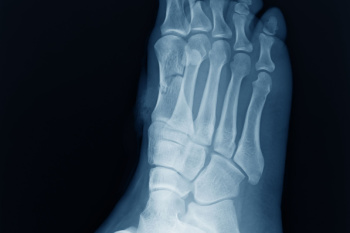Richfield (435) 896-6497
Ephraim (435) 283-4076
Cuboid Syndrome in Athletes
Tuesday, 28 May 2024 00:00 Cuboid syndrome is a condition where the cuboid bone, located on the outer side of the midfoot, becomes partially dislocated or misaligned. This often occurs due to injury or repetitive strain. Athletes are more likely to get cuboid syndrome than other groups because their activities, such as running or jumping, put significant stress on the foot's complex structures. This is especially true for those in sports requiring sudden changes of direction or explosive movements. Symptoms of cuboid syndrome may include intense lateral foot pain, redness, and swelling. A podiatrist, or foot doctor, can treat cuboid syndrome through manual manipulation to realign the bone, along with rest, compression, and elevation to reduce inflammation. Additionally, the use of taping techniques and custom orthotics may help stabilize the cuboid bone and prevent recurrence, allowing athletes to return to their activities with reduced risk of further injury. If you suspect cuboid syndrome, it is suggested you make an appointment with a podiatrist as soon as possible.
Cuboid syndrome is a condition where the cuboid bone, located on the outer side of the midfoot, becomes partially dislocated or misaligned. This often occurs due to injury or repetitive strain. Athletes are more likely to get cuboid syndrome than other groups because their activities, such as running or jumping, put significant stress on the foot's complex structures. This is especially true for those in sports requiring sudden changes of direction or explosive movements. Symptoms of cuboid syndrome may include intense lateral foot pain, redness, and swelling. A podiatrist, or foot doctor, can treat cuboid syndrome through manual manipulation to realign the bone, along with rest, compression, and elevation to reduce inflammation. Additionally, the use of taping techniques and custom orthotics may help stabilize the cuboid bone and prevent recurrence, allowing athletes to return to their activities with reduced risk of further injury. If you suspect cuboid syndrome, it is suggested you make an appointment with a podiatrist as soon as possible.
Cuboid syndrome, also known as cuboid subluxation, occurs when the joints and ligaments near the cuboid bone in the foot become torn. If you have cuboid syndrome, consult with Dr. Blake Zobell from Utah. Our doctor will assess your condition and provide you with quality foot and ankle treatment.
Cuboid syndrome is a common cause of lateral foot pain, which is pain on the outside of the foot. The condition may happen suddenly due to an ankle sprain, or it may develop slowly overtime from repetitive tension through the bone and surrounding structures.
Causes
The most common causes of cuboid syndrome include:
- Injury – The most common cause of this ailment is an ankle sprain.
- Repetitive Strain – Tension placed through the peroneus longus muscle from repetitive activities such as jumping and running may cause excessive traction on the bone causing it to sublux.
- Altered Foot Biomechanics – Most people suffering from cuboid subluxation have flat feet.
Symptoms
A common symptom of cuboid syndrome is pain along the outside of the foot which can be felt in the ankle and toes. This pain may create walking difficulties and may cause those with the condition to walk with a limp.
Diagnosis
Diagnosis of cuboid syndrome is often difficult, and it is often misdiagnosed. X-rays, MRIs and CT scans often fail to properly show the cuboid subluxation. Although there isn’t a specific test used to diagnose cuboid syndrome, your podiatrist will usually check if pain is felt while pressing firmly on the cuboid bone of your foot.
Treatment
Just as the range of causes varies widely, so do treatments. Some more common treatments are ice therapy, rest, exercise, taping, and orthotics.
If you have any questions, please feel free to contact one of our offices located in Richfield and Ephraim, Utah . We offer the newest diagnostic and treatment technologies for all your foot care needs.








